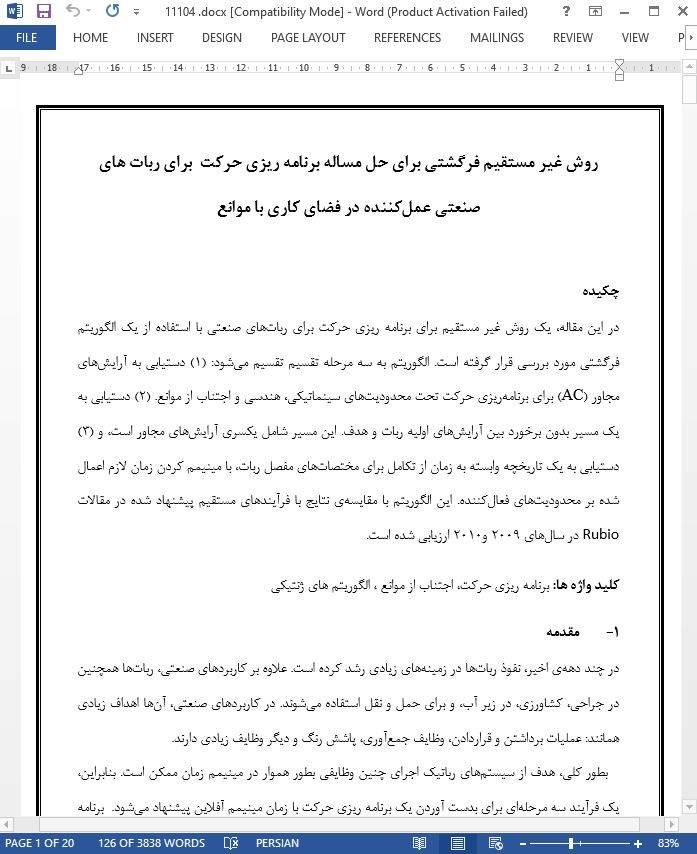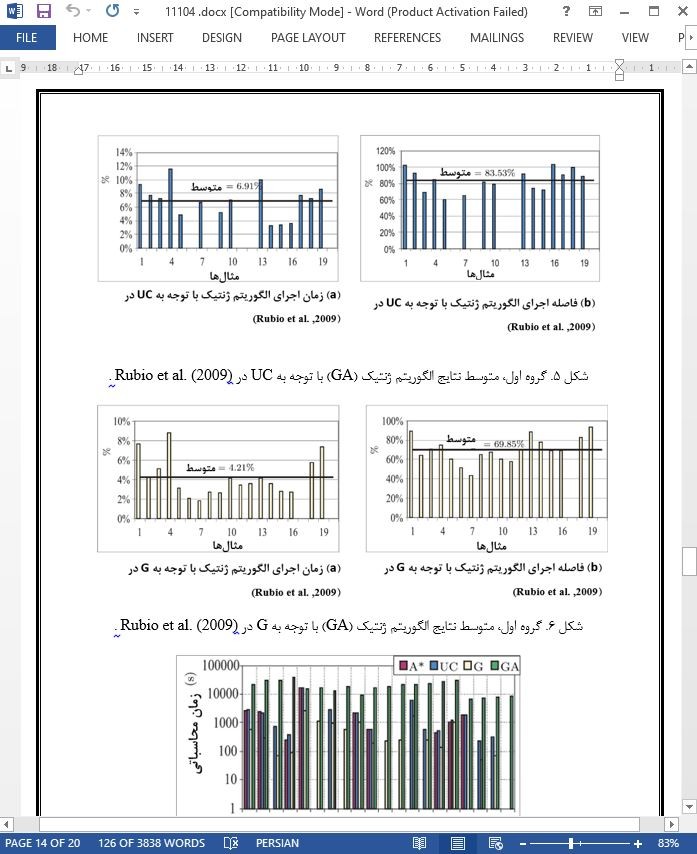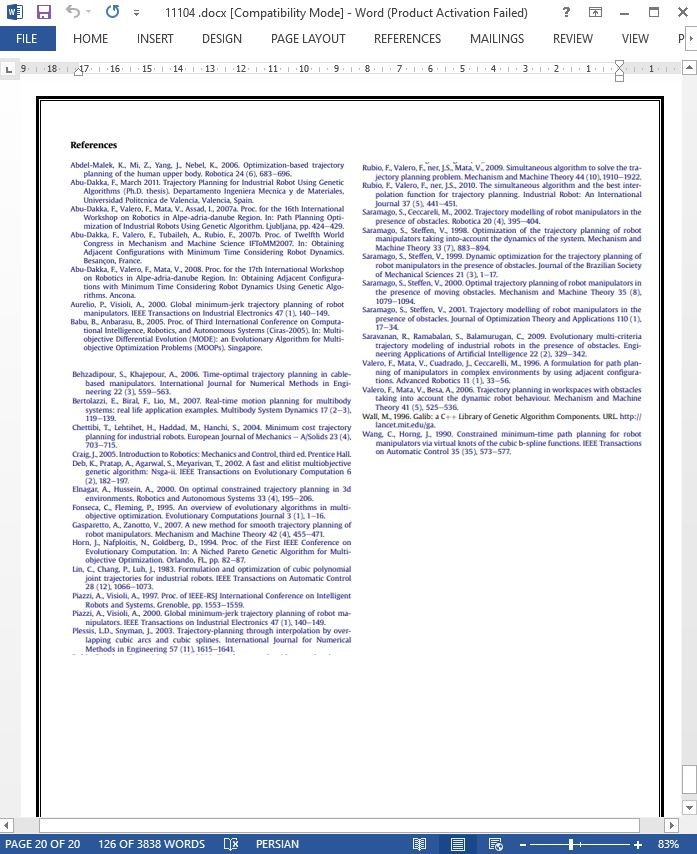
روش غیر مستقیم فرگشتی برای حل مساله برنامه ریزی حرکت
چکیده
در این مقاله، یک روش غیر مستقیم برای برنامه ریزی حرکت برای ربات های صنعتی با استفاده از یک الگوریتم فرگشتی مورد بررسی قرار گرفته است. الگوریتم به سه مرحله تقسیم تقسیم می شود: (1) دستیابی به آرایش های مجاور (AC) برای برنامه ریزی حرکت تحت محدودیت های سینماتیکی، هندسی و اجتناب از موانع. (2) دستیابی به یک مسیر بدون برخورد بین آرایش های اولیه ربات و هدف. این مسیر شامل یکسری آرایش های مجاور است، و (3) دستیابی به یک تاریخچه وابسته به زمان از تکامل برای مختصات های مفصل ربات، با مینیمم کردن زمان لازم اعمال شده بر محدودیت های فعال کننده. این الگوریتم با مقایسه ی نتایج با فرآیندهای مستقیم پیشنهاد شده در مقالات Rubio در سال های 2009 و2010 ارزیابی شده است.
1- مقدمه
در چند دهه ی اخیر، نفوذ ربات ها در زمینه های زیادی رشد کرده است. علاوه بر کاربردهای صنعتی، ربات ها همچنین در جراحی، کشاورزی، در زیر آب، و برای حمل و نقل استفاده می شوند. در کاربردهای صنعتی، آن ها اهداف زیادی همانند: عملیات برداشتن و قراردادن، وظایف جمع آوری، پاشش رنگ و دیگر وظایف زیادی دارند.
بطور کلی، هدف از سیستم های رباتیک اجرای چنین وظایفی بطور هموار در مینیمم زمان ممکن است. بنابراین، یک فرآیند سه مرحله ای برای بدست آوردن یک برنامه ریزی حرکت با زمان مینیمم آفلاین پیشنهاد می شود. برنامه ریزی حرکت آفلاین بعنوان یک تعداد زیادی از کاربردهای رباتیک در یک روش تکراری عمل می کند.
7 نتیجه گیری
در این مقاله، یک الگوریتم فرگشتی سه مرحله ای جدید برای مساله برنامه ریزی حرکت ربات برای ربات های صنعتی در ارتباط با اجتناب از موانع ارائه شده است، در این مورد، برای سناریوهای فضای کاری مختلف با استفاده از یک کنترل کننده 6 محوری PUMA560 بصورت مثال نشان داده شده است. این روش سه الگوریتم فرگشتی شناخته شده پیشین را برای حل سه مرحله ترکیب می کند، که این مراحل شامل (1) اکتساب چیدمان های عاری از برخورد و محتمل با استفاده از SSGA، (2) برنامه ریزی مسیر با مینیمم طول مسیر با محدودیت سینماتیکی و (3) مینیمم زمان برنامه ریزی حرکت که بوسیله ی دینامیک های ربات شرطی شده است. منفعت اصلی روش ارائه شده افزایش عملکرد آن در مقایسه با روش های رایج مربوط به زمان اجرا و مسافت طی شده، می باشد.
Abstract
In this paper, an indirect method for trajectory planning for industrial robots has been addressed using an evolutionary algorithm. The algorithm is divided into three stages: (1) The acquisition of Adjacent Configurations (AC) for Path Planning subjected to kinematics, geometric and obstacle avoidance constraints. (2) The acquisition of a collision-free path between initial and goal robot configurations. This path consists of a set of ACs, and (3) The acquisition of a temporal history of the evolution for the robot joint coordinates, by minimizing the required time subjected to actuator limits. This algorithm has been evaluated by comparing the results with the direct procedures proposed by Rubio articles in 2009 and 2010.
1. Introduction
In the last few decades, the prevalence of robots has grown in many areas. In addition to industrial applications, robots are also used in surgery, agriculture, underwater, and for transportation. In industrial applications, they have many purposes like; pick and place operations, assembly tasks, spray-painting, and many other tasks.
In general, the purpose of robotic systems is to perform such tasks smoothly in as little time as possible. Thus, a procedure of three stages is proposed to obtain an offline minimum time trajectory planning. The offline trajectory planning is justified as a large number of robotic applications work in a repetitive manner.
7. Conclusion
In this paper, a new three-staged evolutionary algorithm for trajectory planning problem for industrial robots in connection with obstacle avoidance has been presented, in this case exemplarily shown for different workspace scenarios using a PUMA 560 six-axis manipulator. This method combines three formerly known evolutionary algorithms to solve the three stages, which are
(1) acquisition of possible and collision-free configurations using SSGA, (2) path planning with minimum path length under kinematic constraint and (3) minimum time trajectory planning conditioned by the robot’s dynamics. The main benefit of the presented method is its performance increase compared to common methods concerning execution time and traveling distance
چکیده
1- مقدمه
2- مدلسازی فضای کاری و ربات
3- بهینه سازی آرایش های همجوار
3-1- الگوریتم های ژنتیک حالت پایدار (SSGA) برای آرایش های همجوار
4- برنامه ریزی مسیر
5- برنامه ریزی حرکت
5-1 تابع هدف
6- مثال های عددی
6-1 اولین گروه: مقایسه با Rubio et al. (2009)
6-2 دومین دسته: مقایسه با Rubio et al. (2009)
6-3 کاربرد صنعتی
7 نتیجه گیری
Abstract
1. Introduction
2. Robot & workspace modeling
3. Adjacent configurations optimization
3.1. SSGA for adjacent configurations
4. Path planning
5. Trajectory planning
5.1. Objective function
6. Numerical examples
6.1. First Group: Comparison with Rubio et al. (2009)
6.2. Second Group: Comparison with Rubio et al. (2010)
6.3. Industrial application
7. Conclusion
- ترجمه فارسی مقاله با فرمت ورد (word) با قابلیت ویرایش، بدون آرم سایت ای ترجمه
- ترجمه فارسی مقاله با فرمت pdf، بدون آرم سایت ای ترجمه



